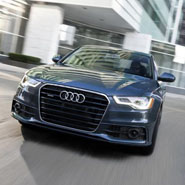- About
- Subscribe Now
- New York,
May 14, 2012

Audi beat out rivals BMW and Mercedes-Benz by creating print and television advertising campaigns that most resonated with affluent consumers by highlighting brand innovation and efficiency, according to a study by Phoenix Marketing International.
The company’s advertising best-practice study found that German automaker Audi produced the strongest marketing campaign in 2011 for its A6 model by addressing common problems drivers face. The automakers that were ranked highest by luxury consumers focused on innovation, style and performance in their ads.
"Historically, performance has always been a primary messaging theme in the luxury category,” said Kevin Severance, senior research analyst at Phoenix Marketing International, Rochester, MI.
“However, with the recent proliferation of alternative fuels and other fuel-efficient technologies, innovation has gained importance in luxury advertising,” he said. “Eco-friendly technologies have become more trendy and desirable in the luxury category."
Phoenix Marketing International, a Honomichl Top-50 market research firm, studied best practices in automotive print and TV advertising study for luxury and non-luxury brands.
Data was collected on a monthly basis from more than 1,800 consumers in the United States who recently purchased or were in the market for a new vehicle.
Audience for Audi
The best-practice study found that three of the top five luxury automaker TV commercials of 2011 came from Audi. One was made by BMW and one was from Cadillac.
In addition, the top-two print ads from luxury automakers were by Audi. Mercedes-Benz also had two print ads in the top five.
"The top-performing luxury car print ads were consistent in terms of their creative layout,” Mr. Severance said.
“Each ad featured a prominent view of the vehicle with a clever tagline and persuasive wording that was clear and direct,” he said.
Audi’s one-page print ads conveyed a blend of style and "intelligent engineering" to announce the redesigned A6 model, per Phoenix Marketing International.
Audi A6 print campaign
These ads were part of the automakers’ A6 campaign that used broadcast, print and digital channels.
Audi showed how the vehicle helps to address problems that a driver faces on the road, such as hazardous driving conditions or other distracted drivers (see story).
Audi A6 TV commercial
“The campaign was successful because the ads showed an attractive vehicle that consumers responded well to,” said Marissa Basile, account manager at Phoenix Marketing International, Rochester, MI.
“The ads casually referenced serious, relatable issues and positioned the vehicle as an innovative solution to those issues,” she said.
Luxury automakers tracked in this study include Audi, BMW, Cadillac, Jaguar, Land Rover, Lexus, Mercedes-Benz, Porsche and Range Rover.
No funny business
The best-practice study found that there is a key difference between the message that resonates with consumers of luxury cars and those of non-luxury cars.
Non-luxury consumers favor ads that are humorous, clever, entertaining and unique, but luxury consumers are more responsive to ads that have a serious tone, portray a brand they want to be associated with and show an attractive vehicle.
Across all media channels and car types, ads that conveyed vehicle innovation and efficiency messages did well, but luxury ads that addressed fuel economy had a better chance of succeeding when combined with performance highlights.
In addition, all successful ads had qualities such as a clear message and believable and informative content.
“While luxury consumers have warmed to eco-friendly technologies because of their gaining popularity, they still do not want to give up performance for fuel economy," Mr. Severance said.
Final Take
Tricia Carr, editorial assistant on Luxury Daily, New York
Share your thoughts. Click here